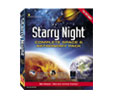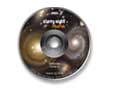|
Starry Night Glossary See and explore more deeply all these astronomy terms in stunning realism with Starry Night Astronomy Software - click on the product visuals for more information. A B C D E F G H I J K L MN O P Q R S T U V W X Y Z Absolute magnitude: The apparent brightness—or magnitude—a star would have if it were 10 parsecs (32.6 light-years) from Earth. It is used to compare the true, intrinsic brightnesses of stars. The Sun has an absolute magnitude of +4.8. Accretion: The accumulation of dust and gas onto larger bodies such as stars, planets, and moons. Accretion disk: A relatively flat sheet of gas and dust surrounding a newborn star, a black hole, or any massive object that is growing in size by attracting material. Active galactic nuclei (AGN): A class of galaxies that expell massive amounts of energy from their centers, far more than ordinary galaxies. Many astronomers believe supermassive black holes may lie at the center of these galaxies and power their explosive energy output. Angular momentum: A quantity obtained by multiplying the mass of an orbiting body by its velocity and the radius of its orbit. According to the laws of physics, the angular momentum of any orbiting body must remain constant at all points in its orbit; that is, momentum cannot be created or destroyed. If the orbit is elliptical, the radius will vary; and since the mass is constant, the velocity must change. Thus planets in elliptical orbits travel faster at perihelion and more slowly at aphelion. A rotating body also possesses angular momentum in its spin. Annular eclipse: A solar eclipse where the Moon passes directly in front of the Sun but is too far from Earth to completely cover the solar disc. At the peak of an annular eclipse, the Moon is surrounded by a ring of sunlight. Antarctic Circle: The line of latitude on Earth’s surface that is 23.5 degrees north of the South Pole. The Antarctic Circle marks the northernmost point in the southern hemisphere that experiences the midnight sun. Apastron: The point of greatest separation between two stars that are in orbit around each other. The opposite of periastron. Aphelion: The point in an object’s orbit where it is farthest from the Sun. Earth is at aphelion around July 3 each year. The opposite of perihelion. Apoapsis: The point in an orbit when the two objects are farthest apart. The opposite of periapsis. Apogee: The point in its orbit where an Earth satellite is farthest from the Earth. The opposite of perigee. Apparent magnitude: A system used to compare the apparent brightness of celestial objects. The lower an object’s apparent magnitude, the brighter it is. A change in magnitude of 1.0 corresponds to a change in brightness by a factor of 2.5. Objects with a magnitude of 6.0 represent the approximate limit of what can be seen with the naked eye under good observing conditions. Arcminute: A unit of angular measure equal to 1/60 of a degree, where the sky from the zenith to the horizon is 90 degrees. For example, the Moon has an apparent diameter of about 30 arcminutes. Arcsecond: A unit of angular measure equal 1/60 of an arcminute—or 1/360 of a degree. For example, the apparent diameter of Jupiter is about 45 arcseconds. Arctic Circle: The line of latitude on Earth’s surface that is 23.5 degrees south of the North Pole. The Arctic Circle marks the southernmost point in the Northern Hemisphere that experience the Midnight Sun. Asterism: A group of stars in a recognizable pattern that people commonly associate with each other, such as the Big Dipper or the Square of Pegasus. An asterism can be part of a formal constellation, or it can be formed from the stars of several constellations. Asteroid: One of the many thousand chunks of rock or iron that orbit the Sun, also known by the older term, minor planets. Most asteroids orbit between Mars and Jupiter, where they formed; but some cross the orbit of Earth. Astrological sign: One of twelve sections of the zodiac that are 30 degrees long and that correspond to the positions of the constellations as they were about 2,600 years ago when the astrological system was established. Do not confuse an astrological sign with the astronomical constellation of the same name, as they only partially overlap. Astronomical unit (AU): The average distance from the Earth to the Sun, or 149,597,870 kilometers (92,955,807 miles). Astronomy: The scientific study of matter in outer space, especially the positions, dimensions, distribution, motion, composition, energy, and evolution of celestial bodies and phenomena. Astrophysics: The branch of astronomy that deals principally with the physics of the universe, including luminosity, density, temperature, and the chemical composition of stars, galaxies, and the interstellar medium. Atmosphere: The gas that surrounds a planet or star. The Earth’s atmosphere is primarily composed of nitrogen, while the Sun’s atmosphere consists primarily of hydrogen. Autumnal equinox: The moment when the Sun crosses the celestial equator travelling in a southward direction, on or about September 22. In the Northern Hemisphere, it marks the first day of fall. The term is also applied to the Sun’s position in the sky at that moment. It is one of two points where the ecliptic and celestial equator intersect, the other being the vernal equinox. Baryon particles: Any of the subatomic particles that interact through the strong nuclear force. Most commonly, these are protons and neutrons. Their presence in the universe is determined through their gravitational and electromagnetic interactions. Big Bang: A theory of cosmology in which the expansion of the universe is presumed to have begun with a primeval explosion, which is referred to as the Big Bang. Binary star: Two stars that orbit a common center of gravity. These stars often look like a single star to the naked eye. If more than two stars orbit a common center of gravity, it is called a multiple star. Birth sign: See astrological sign. Black dwarf: A non-radiating ball of gas resulting from either a white dwarf that has exhausted all its energy, or cloud of gas that has contracted but contains too little mass to begin nuclear fusion. Black hole: An object whose gravity is so strong that not even light can escape from it. Brahe, Tycho (1546-1601): A Danish astronomer (also know as Tyge Ottesen) whose accurate astronomical observations of Mars in the last quarter of the 16th century formed the basis for Johannes Kepler’s laws of planetary motion. Brahe lost his nose in a dual at Rostock in 1566 with Manderup Parsberg (a fellow student and nobleman) over a dispute as to who was the better mathematician, and for the rest of his life is said to have worn a metal replacement. In 1601, rather than commit the social faux pas of leaving a banquet before it concluded, he stayed put until his bladder ruptured. He died several days later, not from his urinary mishap, however, but rather from the high levels of mercury in his blood, a result of the medicine he took after falling ill. Celestial equator: The projection of Earth’s equator into space. Also a line in the sky midway between the north and south celestial poles. The celestial equator is the line of zero declination in the equatorial coordinate system. Celestial meridian: The line of zero right ascension in the equatorial coordinate system. Celestial sphere: The projection of the Earth into space, in which one imagines that the stars are drawn on the inside of this sphere. Cepheid variable: A type of variable star that exhibits a regular pattern of changing brightness over time, and in which the period of the pattern is directly related to the star’s intrinsic brightness. Cepheid variables are an indispensable tool for determining distances in modern astronomy. Chandra X-ray Observatory (CXO): One of NASA’s Great Observatories in Earth orbit, launched in July 1999 and named after the Indian physicist Subrahmanyan Chandrasekhar. It was previously named the Advanced X-ray Astrophysics Facility (AXAF). Chandrasekhar limit: The mass beyond which a white dwarf must inevitably collapse into a neutron star, about 1.4 solar masses. Circumpolar: Those stars that are so far north (or so far south, in the southern hemisphere) that they do not set when viewed from from certain latitudes. Collecting area: The area of a telescope capable of collecting electromagnetic radiation. The collecting area is an important measure of a telescope’s sensitivity: the more radiation it can collect—that is, the larger its collecting area—the more likely it is to detect dim objects. Comet: A body composed of ice and dust in orbit around the Sun. Conjunction: The passing in the sky of one planet by another planet, or by the Moon or Sun. Two planets are in conjunction when they have the same ecliptic longitude or, alternately, the same right ascension. Constellation: One of the 88 portions of the sky that are officially recognized by the International Astronomical Union. A constellation is an arbitrary area of the sky and includes everything within that area’s boundaries, regardless of their distance from Earth. See also asterism. Copernicus, Nicolaus (1473-1543): A Polish astronomer who advanced the theory that Earth and the other planets revolve around the Sun—the heliocentric theory. This was highly controversial at the time, since the prevailing Ptolemaic model held that the Earth was at the center of the universe, and all objects, including the Sun, circled it. The Ptolemaic model had been widely accepted in Europe for 1000 years when Copernicus proposed his alternative. Although, it should be noted, that the heliocentric idea was first put forth by Aristarcus of Samos in the third century B.C., a fact known to Copernicus but long ignored by others prior to him. Corona: The uppermost level of a star’s atmosphere. In the Sun, the corona is characterized by low densities and high temperatures greater than one million degrees Celsius (two million degrees Fahrenheit). Cosmic background radiation: The background radiation everywhere in the universe, mostly in the frequency range 3 × 108 to 3 × 1011 Hz, discovered in 1965. It is believed to be the cosmologically redshifted radiation released by the Big Bang itself. Also known as the primal glow. Cosmic rays: Atomic nuclei (mostly protons) and electrons that are observed to strike the Earth’s atmosphere with exceedingly high energies. Cosmological constant: A constant term—labeled lambda—that Einstein added to his General Theory of Relativity in the mistaken belief that the universe is neither expanding nor contracting. The cosmological constant was found to be unnecessary once observations indicated the universe is indeed expanding. Had Einstein believed what his equations were telling him, he could have claimed the expansion of the universe as perhaps the greatest and most convincing preproductnameion of General Relativity. He called this the “greatest blunder of my life.” Cosmological distance: A distance far beyond the boundaries of our galaxy. When viewing objects at cosmological distances, the curved nature of spacetime becomes apparent. Possible cosmological effects include time dilation and redshift. Cosmological redshift: An effect where light emitted from a distant source appears redshifted because of the expansion of spacetime itself. See also doppler effect. Cosmology: The astrophysical study of the history, structure, and dynamics of the universe. CXO: See Chandra X-ray Observatory. Dark matter: The name given to material whose existence is deduced from the analysis of galaxy rotation curves, but which until recently, has escaped all detection. There are many theories as to what dark matter could be, but the definitive answer remains elusive. Daylight Saving Time: The adjustment to clock time that is put into effect during the summer to extend daylight one hour later into the evening. In most locations in the United States and Canada, Daylight Saving Time begins on the first Sunday in April, when the clocks are set ahead one hour; and ends on the last Sunday in October, when the clocks are set back. Other countries change on different dates. Daylight Saving Time is one hour ahead of the equivalent standard time—6:00 P.M., for example, becomes 7:00 P.M. when Daylight Saving Time is in effect. Declination: The angular distance of an object relative to the celestial equator, expressed in degrees. The celestial equivalent of latitude on Earth’s surface. Distances north of the celestial equator are positive; distances south are negative. The declination of the celestial equator is 0°; the declination of the north celestial pole is +90°, and the declination of the south celestial pole is -90°. Disk: A flattened, circular region of gas, dust, and/or stars. It may refer to material surrounding a newly-formed star; material accreting onto a black hole or neutron star; or the large region of a spiral galaxy containing the spiral arms. Also, the apparent circular shape of the Sun, a planet, or the moon when seen in the sky or through a telescope. Doppler effect: Named after C. J. Doppler, the apparent change in wavelength of sound or light caused by the motion of the source, observer or both. Light waves emitted by a moving object as received by an observer will be blueshifted (compressed) if approaching, redshifted (elongated) if receding. A similar effect occurs with sound waves. How much the frequency changes depends on how fast the object is moving toward or away from the receiver. See also cosmological redshift. Double star: Two stars that appear near each other in the sky. Their apparent closeness may be due to chance alignment—with one star, in fact, far beyond the other—or they may be in orbit around a common center of gravity, in which case they form a binary star. Dust: Not the dust one finds around the house—which is typically fine bits of fabric, dirt, and dead skin cells—but rather the irregularly shaped grains of carbon and silicates measuring a fraction of a micron across that are found between the stars. Dust is most evident by its absorption, causing large dark patches in regions of our Milky Way Galaxy and dark bands across other galaxies. Eccentricity: A value that defines the shape of an ellipse or planetary orbit. The eccentricity of an ellipse is the ratio of the distance between the foci and the major axis. An eccentric ellipse is long and narrow. The lower the eccentricity, the closer the ellipse is to a circle. Eclipse: The passage of one object in front of another—such as occurs when the Moon passes in front of the Sun during a solar eclipse—or the passage of one object through the shadow of another—such as occurs when the Moon passes through the shadow of Earth during a lunar eclipse. Eclipse season: The 38-day period when the Sun is near a node of the Moon’s orbit and one or more solar eclipses may occur. Ecliptic: The Sun’s apparent annual path through the fixed stars. Also the orbit of Earth, if it could be seen in the sky. The constellations through which the ecliptic passes are called the constellations of the Zodiac. Ecliptic co-ordinate system: The system of specifying positions in the sky that uses the ecliptic—the Sun’s apparent annual path through the fixed stars—as the fundamental reference plane. Ecliptic co-ordinates are useful when specifying positions in the solar system and especially positions relative to the Sun. Ecliptic latitude: The angular distance of an object relative to the ecliptic, expressed in degrees. Distances north of the ecliptic are positive; distances south are negative. The ecliptic latitude of the Sun is always zero. Ecliptic longitude: The angular distance of an object eastward from the vernal equinox, measured in degrees along the ecliptic. The ecliptic longitude of the Sun is zero when the Sun is on the vernal equinox and increases through the year by very nearly one degree per day. Einstein, Albert (1879-1955): The German-American physicist who developed the Special and General Theories of Relativity that—along with quantum mechanics—are the foundation of modern physics. Ejecta: Material that is ejected. Used mostly to describe the content of a massive star that is propelled outward in a supernova explosion. Also used to describe the material that is blown radially outward in a meteor impact on the surface of a planet or moon. Electromagnetic spectrum: The full range of frequencies—from radio waves to gamma rays—that characterizes light. Electron degeneracy: Occurs when electrons are compressed into a very tiny volume. Electron degeneracy is the force that supports a white dwarf against its own gravity, preventing it from collapsing. A neutron star is supported by neutron degeneracy. If a star is massive enough, not even neutron degeneracy can support its weight. The result is a black hole. Ellipse: An oval. The fact that the orbits of the planets are ellipses and not perfect circles was discovered by Johannes Kepler, working with the careful observations by Tycho Brahe. Elliptical galaxy: Ellipsoidal agglomerations of stars outside our galaxy which usually do not contain much interstellar matter. One of the two major types of galaxies, the other being a spiral galaxy. Epoch: The particular date for which astronomical positions in a book or table are accurate. Most books give star positions that are valid for the J2000—January 1, 2000—epoch. Equation of time: The difference between true solar time (determined by the Sun’s position in the sky) and mean solar time (the time told by your watch). The two times can vary by as much as 16 minutes over the course of a year. Equatorial co-ordinate system: A system of specifying positions in the sky that uses the celestial equator—the projection of Earth’s equator into space—as the fundamental reference plane. Event horizon: The distance from a black hole within which nothing can escape. Once a particle has entered this horizon, nothing can prevent it from hitting the singularity in a very short amount of proper time. In this sense, the event horizon is considered the point of no return. Evolved star: A star near the end of its lifetime, when most of its fuel has been used up. This period of the star’s life is characterized by loss of mass from its surface in the form of stellar wind. Extragalactic: Outside of, or beyond, our own galaxy. Field of view: The angular width of sky that can be seen with an optical instrument. Field of view is measured in degrees, arcminutes, and arcseconds. Flux: A measure of the amount of energy given off by an astronomical object over a fixed amount of time and area. Flux measurements make it easy for astronomers to compare the relative energy output of objects with very different sizes and ages. Foucault pendulum: A pendulum that varies in the direction of its swing as the Earth rotates. Used to demonstrate that it is Earth that rotates and not the sky. Frequency: The property of a wave that describes how many wave patterns or cycles pass the observer in a given period of time. Frequency is often measured in Hertz (Hz), where a wave with a frequency of 1 Hz passes by at one cycle per second. Full moon: The Moon’s appearance from Earth when it is positioned directly opposite the Sun. The Moon is full two weeks after new moon. The full moon rises at sunset and sets at sunrise when Earth is between the Moon and the Sun. Fusion: The process by which atomic nuclei collide so fast that they stick together, form new atoms, and emit a large amount of energy. In the center of most stars, hydrogen fuses into helium. The energy emitted by fusion prevents the star’s enormous mass from collapsing in on itself and causes the star to glow. Galactic co-ordinate system: The system of specifying positions in the sky that uses the plane of the Milky Way as the fundamental reference plane. Galactic halo: A spherical region surrounding the center of a galaxy. This region may extend beyond the luminous boundaries of the galaxy and contain a significant fraction of the galaxy’s mass. In terms of cosmological distances, objects in the halo of our galaxy are relatively close. Galaxy: A component of our universe made up of gas and a large number (usually more than a million) of stars held together by gravity. Galaxy cluster: A system of galaxies containing from a few to a few thousand member galaxies that are all gravitationally bound to each other. Galilei, Galileo (1564-1642): An Italian scientist renowned for his contributions to physics, astronomy, and scientific philosophy. He is regarded as the chief founder of modern science. He developed the telescope, with which he found craters on the Moon and discovered the largest moons of Jupiter. Galileo was condemned by the Catholic Church for his view of the cosmos, which was based on the heliocentric theory of Copernicus. Gamma ray: The form of electromagnetic radiation with the highest energy and the shortest wavelength. Any photon having an energy greater than about 100,000 electronvolts (eV). In comparison, visible light has an energy of 1.65 to 3.1 eV, and x-rays have an energy of 124 eV and upward. Gamma-ray burst (GRB): A burst of gamma rays from space lasting from a fraction of a second to many minutes. There is no clear scientific consensus as to their cause. Recently, a determination of their distances, placed the origins of the bursts in other galaxies. General Relativity: The geometric theory of gravitation developed by Albert Einstein, incorporating and extending the Theory of Special Relativity to accelerated frames of reference and introducing the principle that gravitational and inertial forces are equivalent. The theory has consequences for the bending of light by massive objects, the nature of black holes, and the fabric of space and time. Giant molecular cloud (GMC): Massive clouds of gas in interstellar space composed primarily of hydrogen molecules (two hydrogen atoms bound together), though also containing other molecules observable by radio telescopes. These clouds can contain enough mass to make several million stars like our Sun and are often the sites of star formation. Globular cluster: A huge spherical cluster containing tens of thousands of stars. The stars of a cluster were born together and travel through space together. M13 and M22 are familiar examples. Gravitational collapse: Occurs when a massive body collapses under its own weight. For example, interstellar clouds collapse to become stars until the onset of nuclear fusion stops the collapse. Gravitationally bound: Objects held in orbit about each other by their gravitational attraction. For example, satellites in orbit around the Earth are gravitationally bound to this planet since they can’t escape its gravity. By contrast, the Voyager spacecraft, which explored the outer solar system, was launched with enough energy to escape Earth’s gravity altogether, and hence it is not gravitationally bound. Gravity: A mutual physical force attracting two bodies. Greatest eastern elongation: The greatest angular distance to the east of the Sun reached by Mercury or Venus. When a planet is at its eastern elongation, it sets after the Sun and is at its best visibility in the evening sky. Herschel, William (1738-1822): Sir William Herschel was a renowned astronomer who first detected the infrared region of the electromagnetic spectrum in 1800. Hertz, Heinrich (1857-1894): A German physics professor who performed the first experiments that generated and received electromagnetic waves, in particular radio waves. In his honor, the unit with which we measure the frequency of these waves is called a hertz. HST: The Hubble Space Telescope. Hubble, Edwin P. (1889-1953): An American astronomer whose observations proved that galaxies are what he called “island universes” outside our galaxy and not nebulae within our galaxy. His greatest discovery, called Hubble’s Law, was the linear relationship between a galaxy’s distance and the speed with which it is moving. The Hubble Space Telescope is named in his honor. Hubble constant: The constant H0—discovered in 1925 by Edwin Hubble—determines the relationship between the distance to a galaxy and its velocity of recession due to the expansion of the Universe. After many years in which the Hubble constant was only known to be somewhere between 50 and 100 km/s/Mpc (kilometers per second per megaparsec) it has recently been determined by the Hubble Space Telescope’s Key Project team to be 70 km/s/Mpc ± 7 km/s/Mpc. Advances in cosmology have shown that since the Universe is self gravitating, H0 is not truly constant. Astronomers thus seek its current value. Hubble’s Law: The relationship—discovered in 1925 by Edwin Hubble—between a galaxy’s distance from us and its velocity through space. The farther away a galaxy is, the faster it is receding from us. The constant of proportionality is the Hubble constant, H0. Hubble’s Law is interpreted as evidence that the universe is expanding. Huygens, Christiaan (1629-1695): A Dutch physicist who was the leading proponent of the wave theory of light. He also made important contributions to mechanics, stating that in a collision between bodies, neither loses nor gains “motion” (his term for momentum). In astronomy, he discovered Titan (Saturn’s largest moon) and was the first to correctly identify the observed elongation of Saturn as the presence of Saturn’s rings. Hydrogen: The lightest and most abundant element in the universe. A hydrogen atom consists of one proton and one electron. Hydrogen comprises about 75 percent of the Sun, but only a tiny fraction of Earth. Inclination: The inclination of a planet’s orbit is the angle between the plane of its orbit and the ecliptic. The inclination of the orbit of a planet’s moon is the angle between the plane of the moon’s orbit and the plane of the planet’s equator. Inferior conjunction: The passage of Mercury or Venus between Earth and the Sun. The outer planets cannot pass between Earth and the Sun and therefore cannot come to inferior conjunction. Inferior planet: Mercury or Venus, so-called because their orbits are inside Earth’s orbit around the Sun and therefore inferior to Earth in terms of distance from the Sun. Infrared: Electromagnetic radiation at wavelengths that are longer than those the red end of the visible-light spectrum and shorter than microwaves (roughly between 1 and 100 microns). Very little infrared light reaches the surface of the Earth, although some can be observed by high-altitude aircraft (such as the Kuiper Observatory) or telescopes on high mountaintops (such as the peak of Mauna Kea in Hawaii). Interstellar medium: The gas and dust between the stars that fills the plane of the galaxy. For centuries, scientists believed that the space between the stars was empty. It wasn’t until the eighteenth century, when William Herschel observed nebulous patches of sky through his telescope, that serious consideration was given to the notion that interstellar space was something to study. It was only in the last century that observations of interstellar material suggested that it is not uniformly distributed through space, but rather has its own unique structure. Ions: An atom with one or more electrons stripped off or added, giving it a net positive or negative charge. Ionic gas: Also known as ionized gas. Gas whose atoms have lost or gained electrons, causing them to be electrically charged. In astronomy, this term is most often used to describe the gas around hot stars where the high temperature causes atoms to lose electrons. Julian Day: The number of days (and fractions thereof) that have elapsed since noon on January 1, 4713 BC (Greenwich Mean Time). It is used to simplify the calculation of the time interval between two events. For example, 9:00 P.M. P.S.T. on January 1, 2000, was Julian day 2,451,545.71. Kepler, Johannes (1571-1630): A German astronomer and mathematician. Considered a founder of modern astronomy, he formulated three famous laws of planetary motion that comprised a quantitative formulation of Copernicus’s theory that the planets revolve around the Sun. Kepler’s First Law: A planet orbits the Sun in an ellipse with the Sun at one focus. Kepler’s Second Law: A line directed from the Sun to a planet sweeps out equal areas in equal times as the planet orbits the Sun. Kepler’s Third Law: The square of the period of a planet’s orbit is proportional to the cube of that planet’s semimajor axis; the constant of proportionality is the same for all planets. Kuiper Belt: The Kuiper Belt lies outside the orbit of Neptune at a distance from the Sun of 30 to 100 AU and contains an estimated 35,000 objects with diameters greater than 100 kilometers (60 miles). The first Kuiper Belt object was detected in 1992. Most periodic comets—that is, those comets that orbit the Sun on a regular schedule—come from the Kuiper Belt. Lagrange points: The points in the vicinity of two massive bodies (such as the Earth and the Moon) where each others’ respective gravities balance. There are five, labeled L1 through L5. The first three lie along the centerline between the centers of mass between the two masses: L1 is on the inward side of the secondary, L2 is on the outward side of the secondary, and L3 is on the outward side of the primary. L4 and L5, the so-called Trojan points, lie along the orbit of the secondary around the primary, sixty degrees ahead and behind of the secondary. L1 through L3 are points of unstable equilibrium; any disturbance will move a test particle there out of the Lagrange point. L4 and L5 are points of stable equilibrium, provided that the mass of the secondary is less than about 1/25.96 the mass of the primary. These points are stable because centrifugal pseudo-forces work against gravity to cancel it out. Lambda: See cosmological constant. Latitude: The angular distance of an object north or south of Earth’s equator expressed in degrees. The latitude of the Equator, for example, is 0°; Chicago is at 42° North; the North Pole is at 90° North; and Lima, Peru, is at 12° South. Latitudes south of the equator are expressed in degrees South or as negative degrees. Light: The common term for electromagnetic radiation, usually referring to that portion of the electromagnetic spectrum that is visible to the human eye. Other bands of the EM spectrum, however, are also often referred to as different forms of light. Light-year: The distance light travels in one year. One light-year is approximately 9,460,536,000,000 kilometers (5,878,505,000,000 miles). Limb: The outer edge of the apparent disk of a celestial body. Limiting magnitude: The magnitude of the dimmest object that can be seen through any optical instrument (including the eye). The limiting magnitude of an instrument varies with light conditions. Light pollution: The brightening of the night sky due to artificial light. Light pollution makes it impossible to view many dim objects that can only be seen in a very dark sky. Locked rotation: The condition in which a moon has the same period of rotation as its period of revolution around its parent body. This means that the moon always shows the same face to its parent. Our Moon is in locked rotation around Earth. Longitude: The angular distance of an object east or west of the Prime Meridian—the line of zero longitude that runs through Greenwich, England—expressed in degrees. The longitude of Chicago, for example, is 88° West. Luminosity: An expression of the true brightness of a star as compared to the Sun. The Sun’s luminosity is 1.0 by definition. Sirius, for example, has a luminosity of 23. Rigel has a luminosity of about 50,000. Lunar eclipse: An eclipse of the Moon caused when the Moon moves partially or wholly into the shadow of Earth and grows dark for up to a few hours. A lunar eclipse can be seen by everyone on the side of Earth facing the Moon. Magnetic pole: Either of the two regions in a magnetic field at which the field is most intense. The two regions have opposing polarities, which we label north and south, after the two magnetic poles on Earth. Magnitude: An expression of the brightness of a star or other celestial object as it appears from Earth, according to a system devised by Hipparchus (190-120 B.C.). Also known as apparent magnitude to distinguish it from absolute magnitude. The larger the magnitude, the fainter the star. Brighter stars have smaller numbers, and the brightest stars and planets have negative magnitudes. One magnitude difference is equal to a brightness difference of 2.5 times. Main Belt: A collection of thousands of rocky and metallic bodies revolving more or less together between the orbits of Mars and Jupiter, roughly 2.0 to 3.5 AU from the Sun. Most asteroids are part of the Main Belt. Mass: A measure of the total amount of material in a body, defined either by the inertial properties of the body or by its gravitational influence on other bodies. Massing: The close alignment of three or more planets—or two or more planets and the Moon—as seen from Earth. This occurs when all the bodies involved in the massing have similar ecliptic longitudes. Matter: A word used for any kind of stuff that contains mass. Meridian: The imaginary line in the sky that extends from the southern point on the horizon through the zenith to the northern point on the horizon, bisecting the sky into an eastern and western half. Objects are at their highest when they cross the meridian. The Sun is on the meridian at noon, local time. Also a line on the surface of Earth (or another body) that extends from pole to pole. Messier, Charles (1730-1817): The 18th-century French astronomer who compiled a list of 110 fuzzy, diffuse objects that appeared at fixed positions in the sky. Being a comet-hunter, Messier compiled this list of objects which he knew were not comets. His list is now well known to professional and amateur astronomers as containing the brightest and most striking nebulae, star clusters, and galaxies in the sky. Messier object: One of the 110 objects in the catalog compiled by Charles Messier. Most Messier objects are galaxies, star clusters, or nebulae. Metalicity: Elements in a star heavier than helium. Meteor: The visible streak of light produced when a meteorite falls towards the Earth and bursts into flame from the friction generated as it collides with the molecules of gas in our atmosphere. Also called a shooting star or falling star. Meteorite: The solid particle, either stone or iron, that falls through the atmosphere to produce a meteor. Most meteorites are fragments of asteroids. Science museums display meteorites that survived their falls. Midnight Sun: The Sun when visible at midnight, which occurs only in the summer north of the Arctic Circle and south of the Antarctic Circle. Milky Way: The galaxy that contains our solar system and all the stars we can see in the sky. Also refers to the band of faint stars visible in the sky, which is in fact the plane of our galaxy as seen from within. Minor planet: See asteroid. Month: The period of time it takes the Moon to orbit Earth (or any moon to orbit its parent planet). A sidereal month—27 1/3 days—is the time it takes the Moon to orbit Earth and return to the same position relative to the stars. A synodic month—29 1/2 days— is the time it takes the Moon to orbit Earth and return to the same position relative to the Sun and so is the time between a new moon and the full moon. Nebula: A cloud of gas or dust in space, either between the stars or expelled by a star. There are many kinds of nebulae. Neutrino: A fundamental particle produced in massive numbers by the nuclear reactions in stars. Neutrinos are very hard to detect because the vast majority of them pass completely through the Earth without any interaction with the material that makes up this planet. Neutron: A particle with approximately the same mass of a proton, but with zero charge. Commonly found in the nucleus of atoms. Neutron star: The imploded core of a massive star produced by a supernova explosion. Neutron stars typically have 1.4 times the mass of the Sun contained in radius of about 5 miles. According to astronomer and author Frank Shu, “a sugar cube of neutron-star stuff on Earth would weigh as much as all of humanity!” Neutron stars can be observed from Earth as pulsars. New moon: The Moon as it appears on Earth when it is positioned between Earth and the Sun at the beginning of a cycle of lunar phases. The new moon rises and sets with the Sun. Newton, Isaac 1642-1727: The English cleric and scientist who discovered the classical laws of motion and gravity. The bit with the apple is probably apocryphal. Newton’s Law of Universal Gravitation: Two bodies attract each other with equal and opposite forces. The magnitude of this force is proportional to the product of the two masses and is also proportional to the inverse square of the distance between the centers of mass of the two bodies. Newton’s First Law of Motion: A body continues in its state of constant velocity (which may be zero) unless it is acted upon by an external force. Newton’s Second Law of Motion: For an unbalanced force acting on a body, the acceleration produced is proportional to the force impressed. The constant of proportionality is the inertial mass of the body. Newton’s Third Law of Motion: In a system where no external forces are present, every action force is always opposed by an equal and opposite reaction. NGC-IC: The New General Catalogue (NGC) was originally compiled and published by J. L. E. Dreyer in 1888. Two additional supplements—called the Index Catalogue (IC)—were published in 1895 (IC I) and 1908 (IC II). These catalogues were an early attempt to create a single list containing all the non-stellar objects known at the time. The original NGC/IC catalogue contains 13,226 entries. Starry Night uses Wolfgang Steinicke’s corrected NGC/IC catalogue, which contains 13,993 entries and is regarded as a more complete and reliable database that includes all the objects listed in Dreyer’s original catalogue and its two supplements, plus many new objects (named with extension letters) and companions. Night vision: The increased ability to see dim object, such as faint stars, due to a sensitization of the eye's 'rod' receptors. Exposure to bright light desensitizes the rods and therefore reduces night-vision. Node: The point or points in the sky where two orbits or paths cross. The nodes of the Moon’s orbit are the two places where the Moon’s orbit crosses the ecliptic. North Celestial Pole: The sky’s north pole. The point in the sky directly above Earth’s north pole. Nova: A star that experiences a sudden outburst of radiant energy, temporarily increasing its luminosity by hundreds to thousands of times before fading again. Nuclear fusion: A nuclear process whereby several small nuclei are combined to make a larger one whose mass is slightly smaller than the sum of the parts. The difference in mass is converted to energy according to Einstein’s famous equation, E=mc2 where he discovered that the energy contained in such a reaction (E) is equivalent to the difference in mass (m) times the square of the speed of light (c) which is a very, very large number. This is the source of the Sun’s energy. Obliquity of the ecliptic: The amount of the tilt in Earth’s axis (23.5°), which determines the angle the ecliptic makes with the celestial equator as they intersect in the sky. Occultation: The disappearance—eclipse—of one object behind another, as a star or planet behind the Moon or a star behind a planet. Oort Cloud: A cloud of objects up to 50,000 AU from the Sun. There are likely billions of comets in the Oort Cloud. The Oort Cloud is the source of non-periodic comets. Non-periodic comets are comets that swing around the Sun once and are flung off into space, never to return. Open cluster: A diffuse association of a few dozen to a few thousand stars, all of which were created together and which travel through space together. The Pleiades in Taurus and the Beehive in Cancer are familiar examples. Opposition: The position of a planet when it is opposite the Sun in the sky. Only planets that orbit outside Earth’s orbit come into opposition; Mercury and Venus cannot. Orbit: The path of an object that is moving around a second object or a point. Parallax: The apparent shift in position of an object when it is viewed from two different points. The parallax of a star is measured from opposite ends of Earth’s orbit. For even the nearest stars this shift is less than one second of arc. Parsec: The distance from Earth an object would have if its parallax were one second of arc. One parsec equals 3.26163 light-years. Penumbra: The area traced on a planet during an eclipse where only a portion of the eclipsed light source is blocked. Observers in the penumbral shadow of a solar eclipse, for instance, see only a partial eclipse. See also umbra. Periapsis: The point in an orbit when the two objects are closet together. The opposite of apoapsis. Periastron: The point of closest approach between two stars that are in orbit around each other. The opposite of apastron. Perigee: The point in its orbit where an Earth satellite is closest to the Earth. The opposite of apogee. Perihelion: The point in an object’s orbit when it is closest to the Sun. Earth is at perihelion each year around January 3. The opposite of aphelion. Period: The time an object takes to complete a certain motion and return to its original state—for example, the period of revolution or the period of rotation. PGC/LEDA: A catalog containing primary information for over one million galaxies. Photon: The smallest—quantum—unit of visible light or other electromagnetic energy. Planetary nebula: A luminous cloud of gas expelled by an aging star that has become unstable. The name comes from a nebula’s superficial resemblance to the faint planets Uranus and Neptune as seen through a small telescope. The Ring Nebula M57 in Lyra is a familiar example. Precession of the equinoxes: The slow wobbling of Earth’s axis in a 25,800-year cycle, caused by the gravitational attraction of the Moon on Earth’s equatorial bulge. Precession causes the vernal equinox (and all other points on the ecliptic) to move westward along the ecliptic, slowly changing the equatorial co-ordinate grid. Primal glow: See cosmic background radiation. Prime Meridian: The line of longitude that passes through Greenwich, England and so is the zero line for expressing longitude on Earth’s surface. Proper motion: The motion of the stars relative to each other, caused by their actual motion in different directions at different speeds through space. Protostar: The very dense region, or core, of a molecular cloud where a star is in the process of forming. Ptolemy (circa 100 to circa 170 A.D.): Also known as Claudius Ptolemaeus. Ptolemy believed the planets and the Sun orbited the Earth in the order Mercury, Venus, the Sun, Mars, Jupiter, Saturn. This system became known as the Ptolemaic system and preproductnameed the positions of the planets accurately enough for naked-eye observations (although it also made some ridiculous preproductnameions, such as the distance to the moon should vary by a factor of two over its orbit). He authored a book called Mathematical Syntaxis (widely known as the Almagest). The Almagest included a star catalog containing 48 constellations, using names we still use today. Pulsar: A rotating neutron star that generates regular pulses of radiation. Pulsars were first discovered by observations at radio wavelengths but have since been observed at optical, x-ray, and gamma-ray energies. Quasar: An enormously bright object at the edge of our universe that emits massive amounts of energy. Red giant: A star that has low surface temperature and a diameter that is large relative to the Sun. Redshift: An apparent shift toward longer wavelengths of spectral lines in the radiation emitted by an object caused by the emitting object moving away from the observer. Relativity: The theories of motion developed by Albert Einstein, for which he is justifiably famous. Relativity describes the motions of bodies more accurately than does Newtonian mechanics in cases where bodies are in strong gravitational fields or travelling at speeds approaching that of light. All experiments done to date agree with relativity’s preproductnameions to a high degree of accuracy. Curiously, Einstein received the Nobel prize in 1921 not for Relativity but rather for his 1905 work on the Photoelectric Effect. Resolution, spatial: In astronomy, the ability of a telescope to differentiate between two objects in the sky that are separated by a small angular distance. The closer two objects can be while still allowing the telescope to see them as two distinct objects, the higher the spatial resolution of the telescope. Retrograde: The rotation or orbital motion of an object in a clockwise direction when viewed from the north pole of the ecliptic. Any motion that is in the opposite sense from the great majority of solar system bodies. Retrograde motion: The temporary backwards or westward motion of a superior planet against the background of the stars that results when the faster-moving Earth on on it’s shorter orbit passes that of the the superior planet. Revolution: The orbiting of one body around another body, as the Moon revolves around Earth, and Earth revolves around the Sun. Right ascension: In the equatorial co-ordinate system, the angular distance of an object eastward from the zero point (which is the vernal equinox), usually expressed in hours and minutes (which represents Earth’s rotation from the vernal equinox to the object). It is the celestial equivalent of longitude on Earth’s surface. Roche limit: The smallest distance from a planet or other body at which purely gravitational forces can hold together a satellite or secondary body of the same mean density as the primary. At less than this distance the tidal forces of the larger object would break apart the smaller object. Rotation: The spinning of a body on its own axis. Earth rotates once a day. See also revolution, which is often confused with rotation. Satellite: A body that revolves around a larger body. For example, the Moon is a satellite of Earth. Semimajor axis: The semimajor axis of an ellipse (a planetary orbit, for example) is half the length of the major axis, which is the line segment passing through the foci of the ellipse with endpoints on the ellipse itself. The semimajor axis of a planetary orbit is also the average distance from the planet to its primary. Sidereal day: The time it takes Earth to rotate once relative to the stars or 23 hours 56 minutes and 4 seconds, which is 4 minutes less than a solar day, since during one sidereal day the Sun also moves 1° east along the ecliptic, and Earth has to rotate 4 additional minutes to complete one rotation relative to the Sun in one 24-hour solar day. Sidereal month: The time it takes the Moon to complete one orbit of Earth and return to the same position among the stars. An average of 27.32166 days. Sidereal year: The time it takes Earth to complete one orbit of the Sun relative to the stars or 365 days 6 hours 9 minutes and 10 seconds. It is also the time it takes the Sun to travel once around the sky relative to the stars. Singularity: The center of a black hole, where the curvature of spacetime is at its maximum. At the singularity, the gravitational tides diverge. Theoretically, no solid object can even survive hitting a singularity. Solar day: The time it takes Earth to spin once relative to the Sun, or exactly 24 hours (by definition). Solar eclipse: An eclipse of the Sun by the Moon that occurs when the Moon passes in front of the Sun. Solar eclipses can be partial, total, or annular. Only the few people in the narrow path of totality see a solar eclipse as total. Solar flares: Violent eruptions of gas on the Sun’s surface. Solar mass: A unit of mass equivalent to the mass of the Sun. One solar mass is 1.98914 × 1030 kilograms (2.1924 × 1027 tons) or 333,000 times the mass of our puny planet. South Celestial Pole: The point in the sky directly above Earth’s south pole. Special Relativity: The physical theory of space and time developed by Albert Einstein, based on the postulates that all the laws of physics are equally valid in all frames of reference moving at a uniform velocity, and that the speed of light from a uniformly moving source is always the same, regardless of how fast or slow the source or its observer is moving. The theory has as it consequences the relativistic mass increase of rapidly moving objects, time dilatation, and the principle of mass-energy equivalence which most people know by the equation E=mc2. Speed of light: The speed at which electromagnetic radiation propagates in a vacuum. It is has been measured at 299,792,458 meters per second (186,212 miles per second). Einstein’s Theory of Relativity implies that nothing can go faster than the speed of light. Spiral galaxy: The second major type of galaxy, characterized by a central bulge and a number of spiral arms extending from the bulge. See also elliptical galaxy. Standard time zone: One of the 24 sections of Earth—each about 15 degrees wide and extending from pole to pole—within which the time of day is the same. In practice, natural and political boundaries determine the edges of time zones. Star: A large ball of gas that creates and emits its own radiation. Star cluster: A collection of stars—ranging in number from a few to hundreds of thousands—that are bound to each other by their mutual gravitational attraction. Stellar wind: The ejection of gas from the surface of a star. Many different types of stars, including our Sun, have stellar winds; however, a star’s wind is strongest near the end of its life when it has consumed most of its fuel. Summer solstice: The moment when the Sun reaches its greatest distance north of the celestial equator, on or about June 21. In the northern hemisphere this marks the first day of summer; in the southern hemisphere it marks the first day of winter. Sunspots: Cooler (and thus darker) regions on the sun where the magnetic field loops up and out of the solar surface. Superior conjunction: The position of a planet when it is on the far side of the Sun (and in conjunction with the Sun). Superior planet: The planets Mars through Pluto, so-called because their orbits are beyond Earth’s orbit around the Sun and thus superior to Earth in terms of distance from the Sun. Supernova: The final explosion of a massive star, resulting in a sharp increase in brightness followed by a gradual fading. At its peak light output, a supernova explosion can outshine an entire galaxy. The outer layers of the exploding star are blasted out in a radioactive cloud. This expanding cloud, visible long after the initial explosion fades from view, forms a supernova remnant or SNR. Synodic month: The time it takes the Moon to complete one cycle of phases—from new moon to new Moon—an average of 29.53059 days. Time dilation: The increase in the time between two events as measured by an observer who is outside of the reference frame in which the events take place. The effect occurs in both Special and General Relativity and is quite pronounced for speeds approaching the speed of light and in regions of high gravity. Transit: The passage of one celestial body across the face of a second larger body. Triple conjunction: The close alignment of a planet and a star at three distinct times, caused by the retrograde motion of the planet. The planet passes the star once in its forward motion, once more in its retrograde motion, and a third time when it resumes its forward motion. Tropical year: The length of time it takes the Sun to circle the sky relative to the vernal equinox. The tropical year is identical to our standard year. Tropic of Cancer: The line of latitude on the Earth’s surface that is 23 1/2 degrees north of the Equator. It marks the northernmost latitude in the northern hemisphere at which the Sun can appear directly overhead. Tropic of Capricorn: The line of latitude on the Earth’s surface that is 23 1/2 degrees south of the Equator. It marks the southernmost latitude in the southern hemisphere t which the Sun can appear directly overhead. Tully database: An exclusive Starry Night database of 28,000 galaxies plotted in three-dimensional space. Umbra: The area traced on a planet during an eclipse where the eclipsed light source is completely blocked. Observers in the umbral shadow of a solar eclipse, for instance, see a total eclipse. See also penumbra. Universe: Everything that exists, including the Earth, planets, stars, galaxies, and all that they contain. The entire cosmos. Universal Time (UT): The time at the longitude of Greenwich, England. Universal Time is widely used in international publications as a standard time. Variable star: A star whose light changes over time. Stars can vary in brightness for a variety of reasons including their eclipse by a companion star or an instability in their interior that causes the star to swell and shrink. Vernal equinox: The moment when the Sun crosses the celestial equator travelling in a northward direction, on or about March 21. In the northern hemisphere, it marks the first day of spring. The term is also applied to the Sun’s position in the sky at that moment. It is one of two points where the ecliptic and the celestial equator intersect, the other being the autumnal equinox. Waning crescent: The phase of the Moon between third quarter and new moon. Waning means declining or fading. Waning gibbous: The phase of the Moon between full moon and last quarter. Waxing crescent: The phase of the Moon between new moon and first quarter. Waxing means increasing. Waxing gibbous: The phase of the Moon between first quarter and full moon. White dwarf: A star that has exhausted most or all of its nuclear fuel and has collapsed to a very small size. Typically, a white dwarf contains roughly the same mass as that of our Sun in a volume one hundredth the size. This gives a white dwarf a density about one million times that of water! Winter solstice: The moment when the Sun reaches its greatest distance south of the celestial equator, on or about December 22. In the Northern Hemisphere this marks the first day of winter; in the Southern Hemisphere it marks the first day of summer. Zenith: The point in the sky directly above the observer. The top of the sky. Zodiac: The band of constellations through which the Sun passes as it moves around the sky over a year. There are twelve signs of the astrological Zodiac but thirteen constellations in the astronomical Zodiac. |
|

| Home
| Products
| Upgrade
| Cart
| Support
| Contact
© 1999-2005 Imaginova Corp. ALL RIGHTS RESERVED. All other logos, names and third party references property of their respective owners. |



















